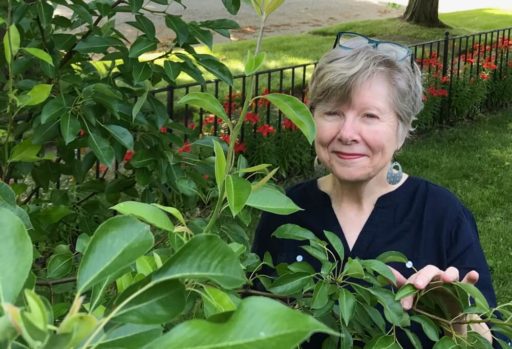We recently spoke with author Valeria Sayers about her new Slant book, The Age of Infidelity.
Why did you choose the title The Age of Infidelity?
My fiction’s always been interested in romantic fidelity as an analogue for religious or spiritual fidelity. Faith is slippery. The characters in this collection are sometimes faithless to their partners or friends, sometimes faithless to their own beliefs or their own sense of longing for the divine.
Did you set out to write a collection about infidelity?
No. Stories present themselves to be written when I least expect it, and these stories came at odd times. At one point, however, I realized how many of them dealt with the theme of infidelity. When I pieced them together, I was struck by how varied the voices were: each says something different, at a different pitch. Taken together, they comment on an age that has witnessed the splintering of our cultural connections and commitments to religious faith, to all kinds of institutions, and to other people.
So what can stories about infidelity do for us beyond pointing out what can go wrong in our relationships?
I think a good story gives us an experience that jars us out of our own mundane life or lets us see ourselves afresh. I hope these stories shift our angles of vision by allowing us to experience characters and cultures who break their promises for complicated reasons, then struggle to set that right. The future looks better for some of them than for others, but each has given voice to the challenge of remaining faithful. And I hope that the experience of hearing those individual and idiosyncratic voices makes readers more sympathetic to those who are faithless and those who feel betrayed.
The settings include the Midwest, New York City, coastal South Carolina, and Ireland. Are those all places important to you?
Indeed they are. I was born and raised in South Carolina during the shameful years of Jim Crow; I spent almost twenty-five years in New York, where I raised my sons; I’ve now been more than twenty-five years in the Midwest, which still feels a little strange to me; and I feel a special connection to Ireland, where virtually all my family began. Almost all these landscapes are dramatic (the exception, I think, is the part of the Midwest I write about, which hides its beauty and reveals it slowly). I use landscape, as so many writers do, to underscore conflict, and all these landscapes work especially well with my latest fiction, which considers the degradation of the planet.
How long does it take you to write a story?
The first draft usually comes quickly, and if it’s at all possible I like to finish that first draft in a week at most; getting the entire story down as quickly as possible helps unify it. The subsequent drafts takes months, but I especially enjoy rewriting—until I don’t. Sometimes I have to put a story away for more months still to be able to see it again fresh, and often when I do that, I can see immediately what work still has to be done.
What motivates you to write stories about the past, the present, or the future?
The stories we choose to tell are often good reflections of our anxieties. A story about the past signals my desire to understand something about what I’ve lived through that hasn’t ever been entirely clear to me; a story about the present helps me deal with my confusion about the current moment; and a story about the future clearly illustrates my fear about where we’re heading if we don’t change course. I don’t know what I’ve learned about my anxieties (philosophical, spiritual, or psychological) until I’ve finished a story. Then I sometimes want to smack my own head as I realize what it is that I’ve been writing about… but at least I then know how to progress through the drafts to come.
What writers have most influenced your short fiction?
Too many to count. Faulkner was the first to convince me to count on voice. Franz Kafka and, more recently, George Saunders, Melanie Rae Thon, and Gina Ochsner have all reminded me of the importance of surprise. Isaac Babel instructs me that brutal realism and lyricism can be compatible. I’ve recently fallen in love with Lucia Berlin and her own antic experiments in comic realism, which remind me of the great Grace Paley, who’s also a role model for art and activism.
There are certain stories, too, that I think of in the middle of the night: Edward P. Jones’s “Old Boys, Old Girls” stuns me over and over. I sometimes find myself picturing scenes from Hisaye Yamamoto’s “Seventeen Syllables” or Natalie Díaz’s flash fiction “The Gospel of No Horse.” J. F. Powers, Katherine Anne Porter, and Eudora Welty are old favorites, Zadie Smith, Kevin Barry, and Claire Keegan more recent ones, especially for their willingness to reinvent the short story every time. I admire the ambition of Louise Erdrich’s and Annie Proulx’s stories, and Maxine Hong Kingston’s nonfiction sometimes strikes me as a series of perfect short stories.
You write novels as well as stories. How would you compare the challenges of each?
A novel needs a writer’s faith as well as a sense of delight that can be constantly renewed. A novel has to be complex enough to entertain (if not consume) a writer over years. Stories are more streamlined affairs, but the desire to perfect every word, every phrase, and every image means they’re hard to let go. The novelist is obsessive, the story writer compulsive. The two genres have different impacts on writer and reader: I prefer Flannery O’Connor’s stories, Hilary Mantel’s novels, but I’ve been instructed by O’Connor’s novels and Mantel’s stories. The best fictions haunt us no matter the length.

